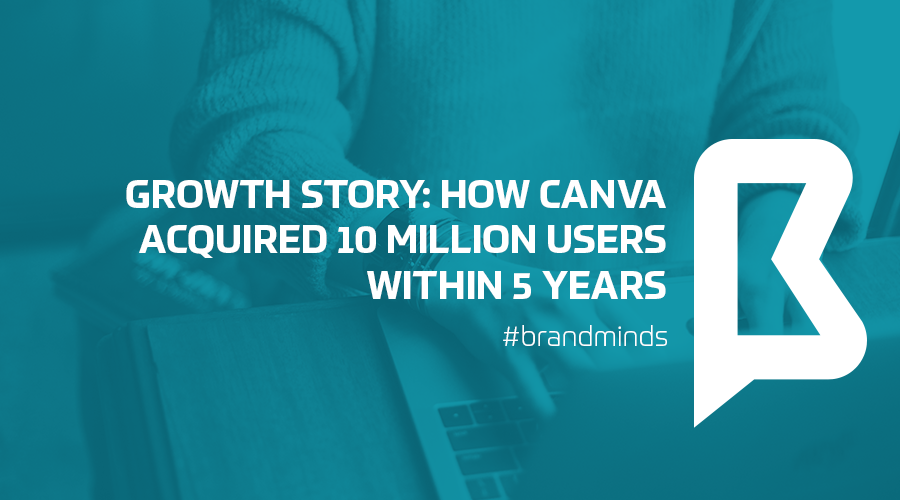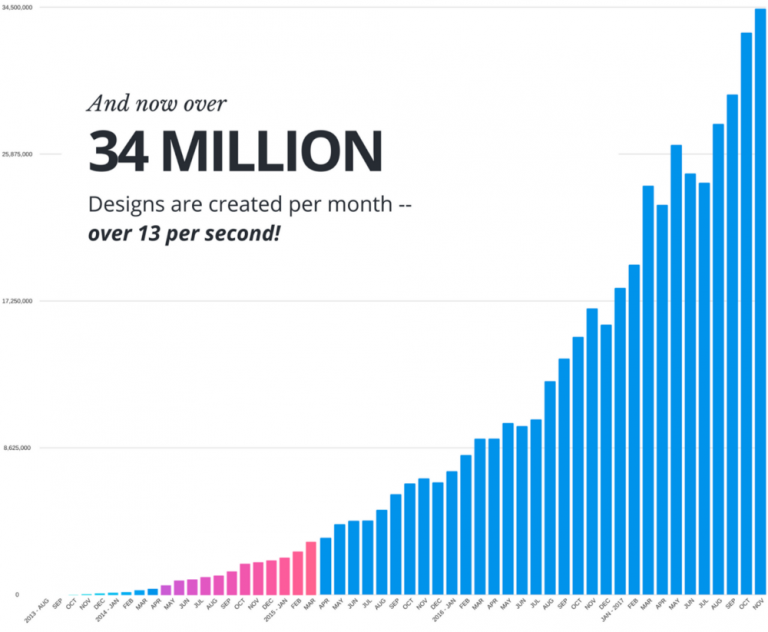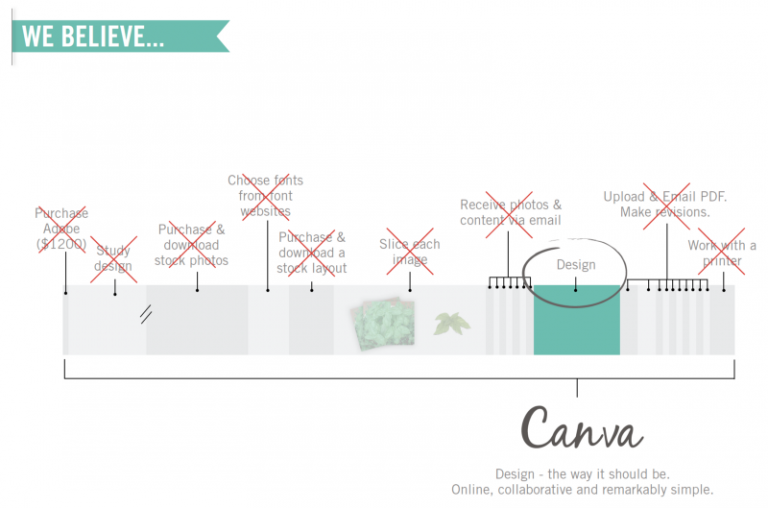Growth Story: How Canva Acquired 10 Million Users within 5 Years

There are 2 billion people on Facebook, 1 billion on Instagram and 500 million on LinkedIn. They use images to communicate and connect on all of these platforms but they are not photographers.
There are over 70 billion businesses using Facebook Pages, 25 million business profiles on Instagram and 18 million company pages on LinkedIn. Businesses hire social media managers to craft their presence and communicate with their followers. Although they are not graphic designers, their employers require them to have image designing abilities. Photoshop and Adobe are tools designed for professional graphic designers, but they are difficult to use by noobs.
What can individuals as well as communication professionals do beside going to graphic designing school?
They use Canva.
Our goal is to enable the whole world to design.
Melanie Perkins, CEO of Canva
Canva provides graphic design software as a service; it is an online collaborative platform dedicated to people who aren’t graphic designers and don’t have funds to hire one for their various needs.

Canva’s tools are simple and very easy to use, its interface is user-friendly and intuitive. The user is provided with a wide range of templates, fonts, colors and free photos to choose from. From Facebook covers to Instagram posts, brochures, infographics, logos, wedding programs etc – you can design anything and the end result looks amazing. Canva makes its users feel empowered to design and let their imagination translate into beautiful visual imagery and graphics.

Cliff Obrecht, Melanie Perkins and Cameron Adams/canva.com
Canva by numbers
Co-founders Melanie Perkins, Cliff Obrecht and tech expert Cameron Adams launched Canva in 2012 to selected professionals.
By January 2014, Canva had 150,000 users and opened publicly.
In April 2014 Guy Kawasaki joined the team as Canva’s Chief Evangelist; two months later the number of users tripled.
By October 2014 there were 1 million users who shared their Canva-designed images on social media, blogs, emails.
In August 2015, Canva announced it has reached 4 million users.
In 2017 the Australian startup reached profitability thanks to 294,000 paying customers.
To date, the do-it-yourself design platform has more than 10 million users across 179 countries with more than 100 million designs.
Canva’s founders raised $86 million since its launch and the company is currently valued at $1 billion.
Canva’s goal is to raise its users number to 3.2 billion (according to techcrunch.com).
- +10 million users
- +100 million designs
- 3 offices
- 200 team members
- $1 billion value

medium.com
Main reason for Canva’s success – a product which solves a problem people care about
While studying at the University of Western Australia, Melanie was teaching students how to use mainstream design software like inDesign and Photoshop, programs that people found hard to learn and even harder to use. She told bbc.com that “It could take a whole semester to learn the very basics. Even the simplest tasks, like exporting a high-quality PDF file, could take 22 clicks.”
You want to make sure that the solution you create, solves a problem that people care about. Find something that is truly significant. Find a problem faced by lots of people.
Melanie Perkins via forbes.com
She became aware she had just stumbled upon a business opportunity – the market needed a much simpler design tool and she was going to develop it. Melanie took her boyfriend Cliff on board and together started Fusion Books, an online design tool that made it easier for students and teachers to create their own yearbook. Fusion Books was a success, but Melanie and Cliff realised that the technology they had developed could be used much more broadly. They recruited Cameron Adams, Canva’s tech co-founder and the three of them began building Canva.

medium.com
4 strategies which supported Canva’s exponential growth
Canva never used paid advertising to tell prospects about its tool. The team developing Canva chose a different approach to grow the company.
1. Developing a great product, listening to user feedback and testing over and over again
Melanie and her team developed a good product but they postponed Canva’s launch to the public until they had a great product. After many months of continually refining, improving and testing the tools, they realised it’s not all about the digital tools, but also about empowering the users. Here is Melanie writing in her article about this moment:
It became quickly apparent that it was not just the tools themselves that were preventing people from creating great designs, but also people’s own belief that they can’t design.
In order for Canva to take off — we had to get every person who came into our product to have a great experience in a couple of minutes.
We needed to change their own self belief about their design abilities, we needed to give them design needs and we needed to make them feel happy and confident clicking around. We needed to get them to explore and play in Canva. No short order! So we spent months perfecting the onboarding experience paying particular attention to users’ emotional journey.
2. Word of mouth advertising and social currency
The 50,000 subscribers to Canva’s waiting list talked first about this amazing online design tool; this attracted early adopters, the first 150,000 people using Canva tools. These early adopters became Canva’s advertising engine by sharing their designs with their friends. Canva grew at a fast pace all through word of mouth and social proof.
Social currency in the sense of our community has always been incredibly valuable for us. More than 10 million people use Canva in 179 countries, and much of that growth has come through word of mouth and our users sharing about us.
Melanie Perkins via forbes.com
3. Influencer Advocacy
Guy Kawasaki learned about Canva through one member of his social media team who was using Canva to create graphics for his posts. When the people at Canva noticed Guy’s social media graphics were designed with their tools, they contacted him and so he became Chief Evangelist of Canva.
The reason Guy was attracted to Canva was that it “could democratise design just as Apple democratised computers and Google democratised information”. Guy Kawasaki coming to Canva and supporting it helped the online design platform double its users numbers.

Guy Kawasaki, Melanie Perkins and Cliff Obrecht/canva.com
4. Empowering content
Besides developing cool digital tools to support users craft wonderful graphics, Canva also empowers its users by helping them improve their designing skills.
Design School is Canva’s knowledge blog, the place where beginners and professionals come for design tips and inspiration. The blog is rich in resources such as tutorials and articles on how to design a brand, how to be more creative, what are the best resume or email templates etc.
One particular article, Benefits of Walking: Why the Greatest Minds take the Longest Walks, went viral with 90.5k shares on Facebook, 5.9k shares on Twitter and 2.4k shares on LinkedIn.
Did you like our article?
Share it with your friends!
This Founder’s Mentality ensures Long-Term Growth for your Business
Long-term growth for his or her business is every founder’s dream.
They all envision a future where their business is achieving its objective – changing the world and their customers’ lives for the better.
While visualising how your business’s future will look like is desirable, having knowledge of real-world challenges of the business environment is mandatory.
Many founders and entrepreneurs starting out their businesses are asking themselves this question:
What is the success rate of businesses?
Statistics say the following:
- 20% of new businesses survive past their first year of operation;
- Around 50% of all businesses no longer exist after five years;
- 1/3 make it past their 10th anniversary (source: usatoday.com)
- 1 in 9 companies sustain more than a minimum level of profitable growth over 10 years (source: Bain&Company).
These low numbers paint a rather gloomy picture.
But don’t let them discourage you!
Research has found the secret behind the successful long-term growth of the 1 in 9 companies mentioned above and this article helps you discover it.
In 2016, Bain & Company, a management consulting firm published its research, which tackled the subject of business crises.
The findings are detailed in How to overcome the predictable crises of growth: The Founder’s Mentality authored by Bain strategists, Chris Zook and James Allen.
The Founder’s Mentality – the study
Bain & Company’s 18-year study looked for answers related to the burning question of
Why are there so little companies capable of sustained growth over a long period of time?
The researchers broke this big question into three more detailed questions. They are:
- What are the primary barriers and challenges that companies face today in their pursuit of sustained and profitable growth?
- What distinguishes the companies that are able to anticipate and address these challenges most successfully from those that fail to achieve their goals?
- Are successful companies set up internally in a fundamentally different way, which allows them to react to challenges and adapt to opportunities better and faster than those that fall short?
The Founder’s Mentality – Key Findings
The results are surprising, but don’t take our word for it: let’s dig in a little deeper.
The Founder’s Mentality Study drew upon a wide range of sources from large, quantitative surveys, large analyses using Bain & Company databases, and an extensive number of discussions, interviews and case studies. You can read about the study’s resources in detail on FoundersMentality.com.
The Bad
Here’s what the researchers have found:
1. 85% of executives say that businesses experiment slow or no growth due to internal factors;
2. The internal barriers to growth cited by executives are:
- revenues growing faster than talent,
- increasing distance from the customer with growth,
- complexity of decision making slowing the company down,
- inability to choose focus and direction,
- mobilizing resources with difficulty
3. There are 3 challenges faced by companies during the course of their life cycle:
- Overload – which typically occurs during a rapid scale-up period (five to ten times);
- Stall-out – when the growth engine in a mature company loses momentum;
- Free fall – when a company’s business model no longer works and performance declines sharply.
The study’s conclusion reveals a paradox of growth:
Growth creates complexity, and complexity is the silent killer of growth.
The Good
All hope is not lost because researchers found the common thread that runs through all businesses, which enjoyed long-term growth.
The companies which surmount these challenges of growth and demonstrate higher levels of business and financial performance have maintained attitudes and behaviours most commonly found in young companies run by strong, successful founders.
The researchers analysed these companies and observed a series of traits related to the ability of them to sustain long-term growth.
They call them Founder’s Mentality.

image source: foundersmentality.com
Here are the main traits of the Founder’s Mentality as depicted by the study:
1. A sense of insurgent mission
The insurgent companies are characterized by a sense of higher purpose, a long-term horizon, and a few spikes in capabilities and assets that make them special and are the centrepiece of their business model.
2. An obsession with the front line
This trait is exhibited by companies characterized by an intellectual curiosity about every detail of the customer experience and of how everything in the business works. Executives use instincts formed at the ground level to make every decision. Frontline employees are empowered and are the heroes of the business; and the customer voice is central to all decisions.
3. An owner’s mindset
The leadership is characterized by a powerful sense of responsibility for employees, customers, products and decisions; an antipathy to bureaucracy; and a bias toward speed in decisions and actions.
Companies that exhibit these traits have sustained long-term growth because:
- They move and adapt faster;
- They are more open-minded;
- Anticipate and adapt to the future.
Three categories of the Founder’s Mentality: Which one are you?

image source: supershazzer.com
The Insurgents
- Bold mission
The team is at war against their industry on behalf of underserved customers. The bold mission means to redefine their industry on behalf of underserved or new and emerging customers.
- Spiky capabilities
The company is world class at those things that really matter for customers and decidedly average at the rest.
Competitiveness comes from sticking to what the company is great at and focusing resources ruthlessly on these few spikey capabilities.
- Limitless horizon
The leaders refuse to be defined by or constrained within the industry in which they first competed. They are constantly pushing against the edges of business definition, redefining the markets in which they compete.

image source: hooklineandclincher.in
The Frontline Obsession
- Customer advocacy
These companies constantly translate strategy and organizational decisions into frontline routines and behaviours in order to serve customers better and earn customer advocacy and loyalty.
- Frontline empowerment
The leaders obsess about the key players in their organization who deliver the value to customers and ensure that these people are the “heroes.”
Leaders do not allow organizational layers or complexity to distract them from this focus on the talent that really matters. Frontline empowerment is a top priority—these companies give their people the authority and resources they need to do what it takes to serve customers better.
- Relentless experimentation
Hundreds of experiments by customer-focused, empowered employees continually innovating and working with their customers to devise new solutions, better service and better products.

image source: canon-europe.com
The Owner Mindset
- Strong cash focus
Leaders are obsessed with the cash generated by the business, which demands they constantly monitor the gross margin of the business and the SG&A line. They constantly reallocate spending to the best use, never allowing resources to be hoarded.
- Bias for action and speed
Leaders of insurgent companies welcome conflict—if quickly resolved—as a path to the best outcomes for the company and its customers. But they won’t tolerate anyone using conflict as an excuse for inaction or to slow the company’s metabolism.
- Aversion to bureaucracy
While systems, processes and procedures become increasingly necessary as a company grows, insurgent leaders seek to balance that need for professionalization by making heroes of those individuals who don’t hesitate to buck the systems if it means doing the right thing for the customer. Leaders accept the occasional chaos that may result as the cost of maintaining that balance.

